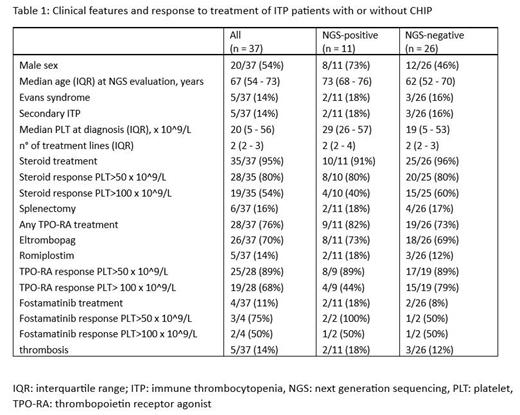Immune thrombocytopenia (ITP) is an acquired disorder marked by immune-mediated attack to platelets. However, the borders between ITP and clonal cytopenias, such as low risk myelodysplastic syndromes, may be difficult to establish. Detection of somatic mutations on peripheral blood leukocytes (PBL) through next generation sequencing (NGS) is gaining diagnostic and prognostic power in myeloid disorders and may be found also in individuals without blood malignancies, namely clonal hematopoiesis with indeterminate potential (CHIP). The prevalence and significance of CHIP in immune-mediated hematological diseases, such as ITP, is not clearly known.
Here we present the preliminary results of a cross-sectional study on adult ITP patients followed at our clinics from 2019 until March 2023. History of any hematological malignancy was an exclusion criterion. An NGS study on PBL was performed by Ion Torrents5, Ion Reporters software 5.2, evaluating mutations in 69 potentially oncogenic genes present in the Oncomine Myeloid Research Assay diagnostic panel. Only mutations with a variant allele frequency (VAF) of 2% were considered, while mutations with VAF > 40% were regarded as potentially germline and discarded. To correlate mutational status with clinical features, a two-tailed Fisher's exact test was used for analysis of dichotomic variables, while a two-sided student's t was used for continuous ones.
We included 37 ITP patients (Table 1), 14 of which (38%) had at least one mutation. After exclusion of 4 mutations with VAF > 40%, a total of 17 mutations were considered, affecting 11/37 (30%) patients (NGS-positive). Mutated genes were TET2 (7/17, 41%), DNMT3A (4/17, 18%), SRSF2 (2/17, 12%), and SF3B1, MPL, ASXL1 and NF1 in 1/17 (6%) case each. All patients, except two, had received at least one treatment line (steroids +/- intravenous immunoglobulins), 32 (86%) and 14 (38%) subjects 2 or 3 lines, respectively.
Median age of NGS-positive was significantly higher than NGS-negative patients: 73 years, interquartile range (IQR) 68 - 76 vs 62 years, IQR 52 - 70 (p = 0.02). NGS-positive had a slightly lower rate of complete response (CR; PLT > 100 x 10 9/L) after steroid treatment, compared with NGS-negative patients (40% vs 60%, respectively). Among the 9 NGS-positive patients who received thrombopoietin receptor agonists (TPO-RA), only 2 were evaluated before, and the remaining after a median of 2.6 years from TPO-RA start. Considering the 9 patients treated with TPO-RA, NGS-positive had a slightly lower rate of CR than NGS-negative patients (44% vs 79%, respectively). In this respect, we did not find substantial disparities in distribution or VAF of gene mutations between patients who fully responded to TPO-RA and those failing to achieve CR.
With the caveat of a cross-sectional analysis in a limited number of cases, these data show the presence of CHIP in 1/3 of multi-treated ITP patients, a frequency similar to that of a much more elderly Italian population >80-year-old (Rossi et al, Blood. 2021), suggesting a possible role of autoimmunity/inflammation and treatment in clonal selection.
Disclosures
Barcellini:Alexion, AstraZeneca Rare Disease: Consultancy, Membership on an entity's Board of Directors or advisory committees, Research Funding; Novartis: Consultancy, Honoraria, Speakers Bureau.


This feature is available to Subscribers Only
Sign In or Create an Account Close Modal